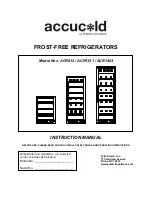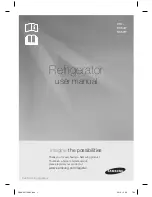
Care and cleaning of the refrigerator.
Preparing for Vacation
For long vacations or absences, remove food and
unplug the refrigerator. Move the control to the OFF
position, and clean the interior with a baking soda
solution of one tablespoon (15 ml) of baking soda to
one quart (1 liter) of water. Leave the door open.
Defrosting (on manual defrost models only)
Defrost whenever frost on the wall of the
ice tray compartment becomes 1/4” thick.
Never use a sharp or metallic instrument to
remove frost as it may damage the cooling
coils. (A punctured cooling coil will cause
serious problems and void the warranty.) We
recommend using a plastic scraper. Do not
use any electrical device in defrosting your
refrigerator.
To defrost:
Remove foods and ice trays from the ice tray
compartment.
Set the temperature control dial at OFF
position.
On models without a drip tray, place a pan
beneath the ice tray compartment to collect
water.
Defrosting usually takes a few hours. To defrost
faster, keep the door open. Also, pouring warm
(not hot) water on the frosted part may speed
defrosting. Do not use boiling water
³LWPD\
damage plastic parts.
After defrosting:
Empty water from the drip tray or from
the pan placed beneath the ice tray
compartment. Wash the tray or pan with
warm water.
Wipe the ice tray compartment with a damp
cloth.
Turn the temperature control to the desired
setting and return food and ice trays to the
refrigerator.
NOTE: If ice buildup is very thick, it may keep
the ice tray compartment door from opening
or closing completely. Don’t try to force it open;
after defrosting, the door will open and close
easily.
Preparing to Move
Secure all loose items such as shelves and
ice trays by taping them securely in place to
prevent damage.
Be sure the refrigerator stays in an upright
position during moving.
6







































